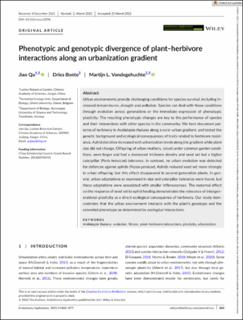| dc.contributor.author | Qu, Jiao | |
| dc.contributor.author | Bonte, Dries | |
| dc.contributor.author | Vandegehuchte, Martijn L. | |
| dc.date.accessioned | 2023-02-09T07:02:36Z | |
| dc.date.available | 2023-02-09T07:02:36Z | |
| dc.date.created | 2022-06-07T19:28:22Z | |
| dc.date.issued | 2022 | |
| dc.identifier.citation | Evolutionary Applications. 2022, 15 (5), 865-877. | en_US |
| dc.identifier.issn | 1752-4571 | |
| dc.identifier.uri | https://hdl.handle.net/11250/3049460 | |
| dc.description.abstract | Urban environments provide challenging conditions for species survival, including increased temperatures, drought and pollution. Species can deal with these conditions through evolution across generations or the immediate expression of phenotypic plasticity. The resulting phenotypic changes are key to the performance of species and their interactions with other species in the community. We here document patterns of herbivory in Arabidopsis thaliana along a rural–urban gradient, and tested the genetic background and ecological consequences of traits related to herbivore resistance. Aphid densities increased with urbanization levels along the gradient while plant size did not change. Offspring of urban mothers, raised under common garden conditions, were larger and had a decreased trichome density and seed set but a higher caterpillar (Pieris brassicae) tolerance. In contrast, no urban evolution was detected for defences against aphids (Myzus persicae). Aphids reduced seed set more strongly in urban offspring, but this effect disappeared in second-generation plants. In general, urban adaptations as expressed in size and caterpillar tolerance were found, but these adaptations were associated with smaller inflorescences. The maternal effect on the response of seed set to aphid feeding demonstrates the relevance of intergenerational plasticity as a direct ecological consequence of herbivory. Our study demonstrates that the urban environment interacts with the plant's genotype and the extended phenotype as determined by ecological interactions. | en_US |
| dc.language.iso | eng | en_US |
| dc.publisher | John Wiley & Sons | en_US |
| dc.rights | Navngivelse 4.0 Internasjonal | * |
| dc.rights.uri | http://creativecommons.org/licenses/by/4.0/deed.no | * |
| dc.title | Phenotypic and genotypic divergence of plant–herbivore interactions along an urbanization gradient | en_US |
| dc.title.alternative | Phenotypic and genotypic divergence of plant–herbivore interactions along an urbanization gradient | en_US |
| dc.type | Peer reviewed | en_US |
| dc.type | Journal article | en_US |
| dc.description.version | publishedVersion | en_US |
| dc.source.pagenumber | 865-877 | en_US |
| dc.source.volume | 15 | en_US |
| dc.source.journal | Evolutionary Applications | en_US |
| dc.source.issue | 5 | en_US |
| dc.identifier.doi | 10.1111/eva.13376 | |
| dc.identifier.cristin | 2030066 | |
| cristin.ispublished | true | |
| cristin.fulltext | original | |
| cristin.qualitycode | 2 | |

